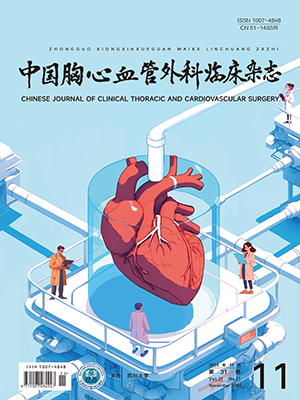Abstract: Objective To analyze the results of preoperative evaluation of the operability of chronic thromboembolic pulmonary hypertension (CTEPH), and to find parameters to define the inconsistency between the operable lesions of CTEPH and pulmonary vascular resistance (PVR). Methods A total of 133 patients with CTEPH admitted into Anzhen Hospital were enrolled for preoperative assessment of operability from March 2002 to May 2010. There were 86 males and 47 females with an age of 49.10±22.70 years. The patients were divided into operable group (group A, n=82,age of 47.80±21.60 years) and inoperable group (group B, n=51, age of 50.30±23.40 years) according to the assessment suggestion. We evaluated the occluded pulmonary segment(OPS) of all the patients through pulmonary ventilation/perfusion scintigraphy, and measured the plasma aminoterminal Btype natriuretic peptide (NT-pro BNP) and PVR. Then the ratio of NT-pro BNP to OPS and PVR to OPS were calculated. [CM(159mm]Results Out of the 82 patients with CTEPH in group A, 81 were positive in the anesthesia test and were subject to pulmonary thromboendarterectomy(PTE). In the whole cohorts of operated patients, there was one early death due to persistent pulmonary hypertension and right heart failure. The specificity of the anesthesia test was 98.78%. Eighty patients (98.77%) were followed up in this group for a period of 1 to 95 months (42.70±28.40 months). During the followup, there was one late death due to pulmonary artery hypertension crisis. Among the 51 patients with CTEPH in group B, there were 32 patients (62.75%) with surgically inaccessible lesions, 13 patients (25.49%) with surgical accessible CTEPH concomitant with severe diseases, and 6 patients (11.76%) with inconsistency between the surgical accessible lesion and high PVR. The ratio of NT-pro BNP to OPS and PVR to OPS for the 81 positive patients in group A was in the range of 80-150 pg·ml-1/OPS and 50-100 dyn·s·cm-5/OPS, respectively. The ratio of NT-pro BNP to OPS (315.00±83.00 pg·ml-1/OPS vs. 115.60±40.50 pg·ml-1/OPS, P=0.000) and PVR to OPS (190.00±57.00 dyn·s·cm-5/OPS vs. 76.40±26.30 dyn·s·cm-5/OPS, P=0.000) for the 6 patients with incosistency between the surgical accessible lesion and high PVR in group B were significantly higher than that for the 81 positive patients in group A. Conclusion Surgically inaccessible CTEPH lesions, CTEPH concomitant with severe diseases, and inconsistency between surgical accessible lesion and high PVR are the three most frequent reasons for denying PTE procedure. The ratio of NTpro BNP to OPS and PVR to OPS may serve as the parameters to define the inconsistency between the surgical accessible lesion and high PVR. Anesthesia test before the PTE procedure may serve as the last evaluation method for the assessment of the operability of CTEPH.
Citation: GAN Huili,ZHANG Jianqun. Analysis on Preoperative Evaluation of the Operability of Chronic Thromboembolic Pulmonary Hypertension. Chinese Journal of Clinical Thoracic and Cardiovascular Surgery, 2011, 18(3): 199-203. doi: Copy




